Paper Mario: The Thousand-year Door
Released: July 22, 2004
Paper Mario: The Thousand-Year Door is a role-playing video game developed by Intelligent Systems and published by Nintendo for the Nintendo GameCube video game console in 2004 . It is the fourth game in the Mario RPG series, and uses the same gameplay and visual style as its predecessor Paper Mario for the Nintendo 64 but with improved visuals.
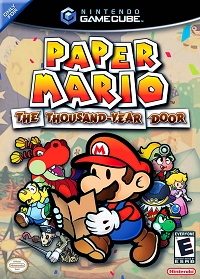
Paper Mario: The Thousand-Year Door opens with a short introduction about a prosperous seaside town that was destroyed by a cataclysm and then sank into the depths of the earth. After the site of the town was completely purged of all evidence of its existence, another, new town called Rogueport, was built there. A legend about a mysterious treasure soon spread through the town. Princess Peach , who was on vacation, visits the town and meets a merchant. The merchant gives her a small box, which is said to only open for one with a pure and noble heart, and says that if Peach can open it, she may have whatever is inside. Peach is, of course, able to open the box, and she gains possession of the magical treasure map . She then sends it to Mario, accompanied by a letter telling him to meet her in Rogueport to join her for a treasure hunt.
Mario sets sail for Rogueport, and after arriving at the docks, he does not find Peach. He soon encounters Goombella, a Goomba girl, being harassed by a mysterious figure named Crump , whom he helps her escape from. Upon showing Goombella the map, she asks him to take it to her archaeology professor, Professor Frankly. The two meet with Frankly, and he identifies the map as the magical map that reveals the location of the seven Crystal Stars. The Crystal Stars are the key to unlocking a magical door, located in the ruins beneath Rogueport, known as the Thousand-Year Door, behind which the legendary treasure of Rogueport is believed to lie. He asks Mario how he came upon the map, and Mario tells him that Peach sent it to him. The three then enter the sewers and unlock a chest that has someone asking for help, but when he opens it he gets cursed with the ability to transform into a paper airplane. When they approach the door with the map, the map shows a castle with the star to the east of Rogueport. Mario's only hope of finding her is to pursue the Crystal Stars, hoping that he will encounter her along the way.
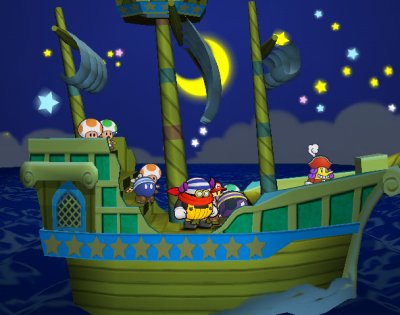
Unbeknownst to Mario, Princess Peach has actually been kidnapped by a group known as the X-Nauts , led by Sir Grodus , who had heard that she was in possession of the map, and kidnapped her only to find that the map was gone. Despite this, Grodus refuses to release her, claiming that he needs her for an undisclosed purpose. During her confinement in the X-Nauts' fortress, Peach encounters a computer called TEC. Though a computer, TEC seems to have an affection for Peach and gradually provides her with information about the X-Nauts' plot and allows her to send e-mail messages to Mario. It is eventually revealed that the "treasure" hidden behind the Thousand-Year Door is actually a demon known as the Shadow Queen. Nearly one thousand years ago, this demon descended upon the prosperous city which lay where Rogueport now lies and destroyed it. She afterwards forged the seven Crystal Stars and used their power to dominate the land. However, her reign was crushed when four heroes managed to steal the Crystal Stars and used them to imprison her inside of her own palace, which she had constructed on the ruins of the prosperous city. They afterwards hid the Crystal Stars in remote locations across the land to prevent them from being found, but knowing that they might one day be needed again created a magical map which could lead its bearer to their locations. Grodus seeks to recover the Crystal Stars and resurrect the demon, whose power he desires to use to conquer the world. Unknown to him, however, the seal placed on the demon's palace would only last for a thousand years, and that this time limit had nearly expired.
Throughout his travels, Mario eventually succeeds in finding all seven of the Crystal Stars and uses their power to open the Thousand-Year Door, intending to enter the Shadow Queen's palace and destroy her. Upon reaching the entrance to her chamber, he encounters Grodus with Peach as his hostage and does battle with him. He is defeated, but Mario is attacked by Bowser, who at last manages to find him and Peach. With Bowser distracting Mario, Grodus manages to escape with Peach into a corridor leading to the area where the Shadow Queen is imprisoned. He summons her and and offers Peach as a new body for her to inhabit, as her old body had been destroyed during her confrontation with the four heroes. Upon possessing Peach, the demon begins to spread darkness across the skies, signaling her return to domination of the world. Grodus orders Shadow Peach to destroy Mario, but taking a dislike to being ordered, strkes Grodus with bolts of black lightning and blows him away, and afterwards confronts Mario. During the ensuing battle, the demon reveals herself to be too powerful for Mario to defeat. Just as it looks as though Mario has lost, the seven Crystal Stars become animated and fly to different location across the region. Upon encountering the Crystal Stars, the inhabitants of each region are able to use the Crystal Stars as a medium through which they see the battle between Mario and the Shadow Queen which will decide the fate of the world, and begin to cheer for Mario's victory. The people's wishes temporarily weaken the Shadow Queen's hold on Peach. With the last of her power, Peach heals Mario and fills up all of his gauges. Then, the final battle begins. After their victory over the Shadow Queen, Mario and Peach return to the Mushroom Kingdom, although the player can choose to go back to Rogueport and continue gameplay.
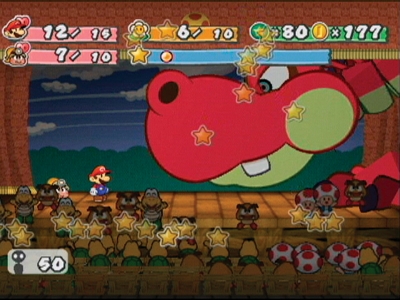
Gameplay
Unique elements
The Thousand-Year Door has some unique elements which owe to its very singular visual style. The graphics consist of a mixture of three dimensional environments and two dimensional characters, who look as if they are made of paper . At different points in the game, Mario is "cursed" with abilities that enable special moves in the overworld, all of which are based on the paper theme. These include:
- Becoming a paper airplane and flying for short distances.
- Turning sideways to become as thin as a piece of paper and slip through cracks.
- Rolling into a tube to duck under low-hanging objects.
- Folding into a boat to cross water.
A variety of other visual effects in the world also play on this theme. Illusory objects that conceal secret items or switches can be blown away by a gust of wind, as they are actually pieces of paper with the object drawn on them stuck onto the page of the game world. Some switches cause changes in the world in ways that match the paper theme, such as a bridge appearing by way of a flipbook -like animation or stone stairs being folded out from a single piece of stone-colored paper.
Another feature this game includes is the ablilty for the player to control Bowser in certain parts of the game. These segments have the player control Bowser in a true side-scrolling environment (reminiscent of the original Super Mario Bros. levels, with a remix of the Super Mario Bros. theme music). The only Power-up of these minigames is a cut of ham, which increases Bowser's size. Several of these can be collected until Bowser becomes gargantuan and invincible.
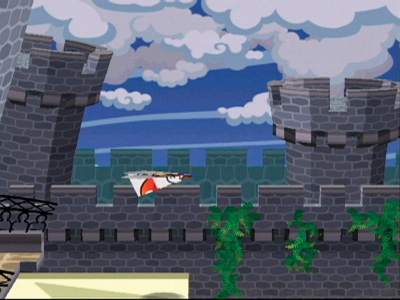
Battle system
Battles in The Thousand-Year Door borrow heavily from the original Paper Mario , Mario and Luigi: Superstar Saga , and Super Mario RPG . The turn-based system, in which players select an attack, defense, or item from a menu, is augmented by timed button presses that, when performed correctly, can result in substantial attack or defense bonuses. In contrast to both Paper Mario and Superstar Saga , battles in The Thousand-Year Door happen on a stage in front of an audience. As the characters perform more advanced attacks, the audience grows, and Star Power is awarded based on the size of the audience. Having Star Power in turn lets the player perform special moves. However, when the player fails to execute a timed button press in time, some of the audience members may run away. The size of the auditorium in which battles take place is affected by the fame ranking, which increases every ten levels up until Level 30. The player begins with a fame ranking of "Rising Star" (50 seats), then "B-List Star" (100 seats), then "A-List Star" (150 seats) and finally "Superstar" (200 seats).
In The Thousand-Year Door , Mario's party members now each have their own Heart Points and they may receive any attack that Mario can receive. When a partner's Heart Points are reduced to 0, the partner becomes inactive for the rest of that battle and later battles until at least one of its Heart Points are restored. If Mario's Heart Points are reduced to 0, however, the game ends even if partners are still available (The only exceptions to this rule is when the party has a life mushroom in their inventory or when Mario is defeated during a fight in the Glitz Pit). Flower Points are shared between Mario and his party members.
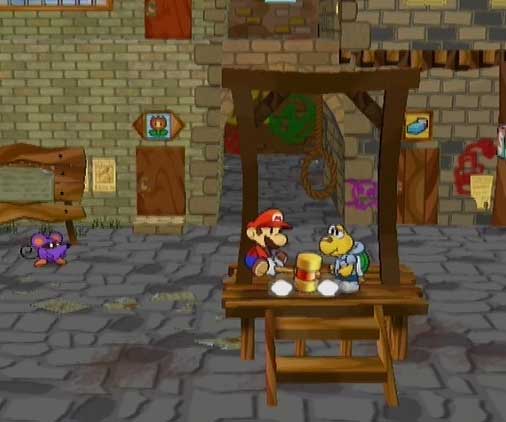
Defeating enemies awards various numbers of Star Points to Mario; for every 100 Star Points, Mario is able to level up , choosing between three character statistic enhancements. Selecting Health (HP) adds the specified number of points to Mario's maximum Heart Points, allowing him to last longer in battle; opting for Flower Points (FP) gives Mario and his partners additional ability to perform special moves; and finally selecting Badge Points (BP) increases the number of badges Mario can equip at any given time. In The Thousand-Year Door , Mario's maximum level is 99, as opposed to 27. Also, there is a limit to Heart Points (200), Flower Points (200), and Badge Points (99) as in the original Paper Mario.
Eventually, individual enemies may give him no Star Points; however, Mario will gain at least one Star Point after winning a battle.
Badges
Paper Mario: The Thousand-Year Door retains the "Badge" system introduced in Paper Mario . Equipping a Badge can do various things; some Badges provide boosts in offense and defense, some provide additional attacks, some increase the player's character statistics, and others only cause aesthetic changes to the game. There are many Badges in the game, and each one has a unique power. Each Badge (besides the ones that only have aesthetic effects, such as the Attack FX Badge series, or detrimental badges like Double Pain) takes a certain number of Badge Points, or BP, to equip; as noted above, players can increase Mario's total BP when he levels up. There are also "P" Badges, which have the same name as their standard counterparts but with a "P" tacked to the end (e.g. "Pretty Lucky P"), which affect Mario's partners rather than himself. In The Thousand-Year Door , Badges can be bought and sold at certain shops, a change from Paper Mario .
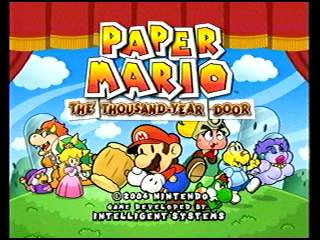
Audience and Stage
In contrast to both Paper Mario and Superstar Saga , battles in The Thousand-Year Door happen on a stage in front of an audience. As the characters perform more advanced attacks, the audience grows, and Star Power is awarded based on the size of the audience. Having Star Power in turn lets the player perform special moves. However, when the player fails to execute a timed button press in time, some of the audience members may run away. Also, by preforming a second timed button press, you can get a "Stylish" action, which triples the amount of Star Power you gain. The size of the auditorium in which battles take place is affected by the fame ranking, which increases every ten levels up until Level 30. The player begins with a fame ranking of "Rising Star" (50 seats), then "B-List Star" (100 seats), then "A-List Star" (150 seats) and finally "Superstar" (200 seats).
Audience members can also throw items to Mario. Sometimes, if you have space in your item menu, it will be added to your items to be used. However, some members can throw items to damage Mario, such as rocks, cans,bones, or hammers. They can also make the background of the stage fall on Mario and hurt him, but it may also hurt your opponent, depending on the defense. The audience does many other things too, such as making a fork, or a bucket fall on Mario, hurting him.
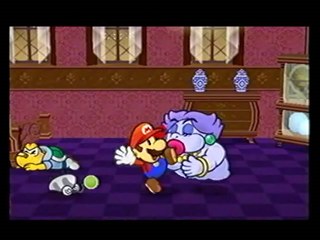
Bosses
| Lord Crump | A Rogue's Welcome | Rogueport |
| Blooper | A Rogue's Welcome | Rogueport Sewers |
| Fuzzies (Mini-Boss) | Castle And Dragon | Schwonk Fortress |
| Skeleton Mob (Mini-Boss) | Castle & Dragon | Hooktail Castle |
| Hooktail | Castle & Dragon | Hooktail Castle |
| The Shadow Sirens | The Great Boggly Tree | Boggly Woods |
| Magnus Von Grapple | The Great Boggly Tree | The Great Tree |
| Bowser | Of Glitz And Glory | Glitz Pit |
| Rawk Hawk | Of Glitz And Glory | Glitz Pit |
| Macho Grubba | Of Glitz And Glory | Glitz Pit |
| Atomic Boo (Optional) | For Pigs The Bell Tolls | Creepy Steeple |
| ????? | For Pigs The Bell Tolls | Creepy Steeple |
| Doppelganger Mario (Unbeatable) | For Pigs The Bell Tolls | Twilight Forest |
| Doopliss | For Pigs The Bell Tolls | Creepy Steeple |
| Cortez | The Key To Pirates | Pirate's Grotto |
| Lord Crump 2 | The Key To Pirates | Keelhaul Key |
| Smorg Miasa | 3 Days Of Excess | Excess Express |
| Magnus Von Grapple 2.0 | Mario Shoots The Moon | X-Naut Fortress |
| Skeleton Mob 2 (Mini-Boss) | The Thousand Year Door | Palace Of Shadow |
| Gloomtail | The Thousand Year Door | Palace Of Shadow |
| Shadow Sirens And Doopliss | The Thousand Year Door | Palace Of Shadow |
| Grodus | The Thousand Year Door | Palace Of Shadow |
| Bowser and Kammy Koopa | The Thousand Year Door | Palace Of Shadow |
| Shadow Queen | The Thousand Year Door | Palace Of Shadow |
| Bonetail (Optional) | Any Chapter | Pit Of 100 Trials |

